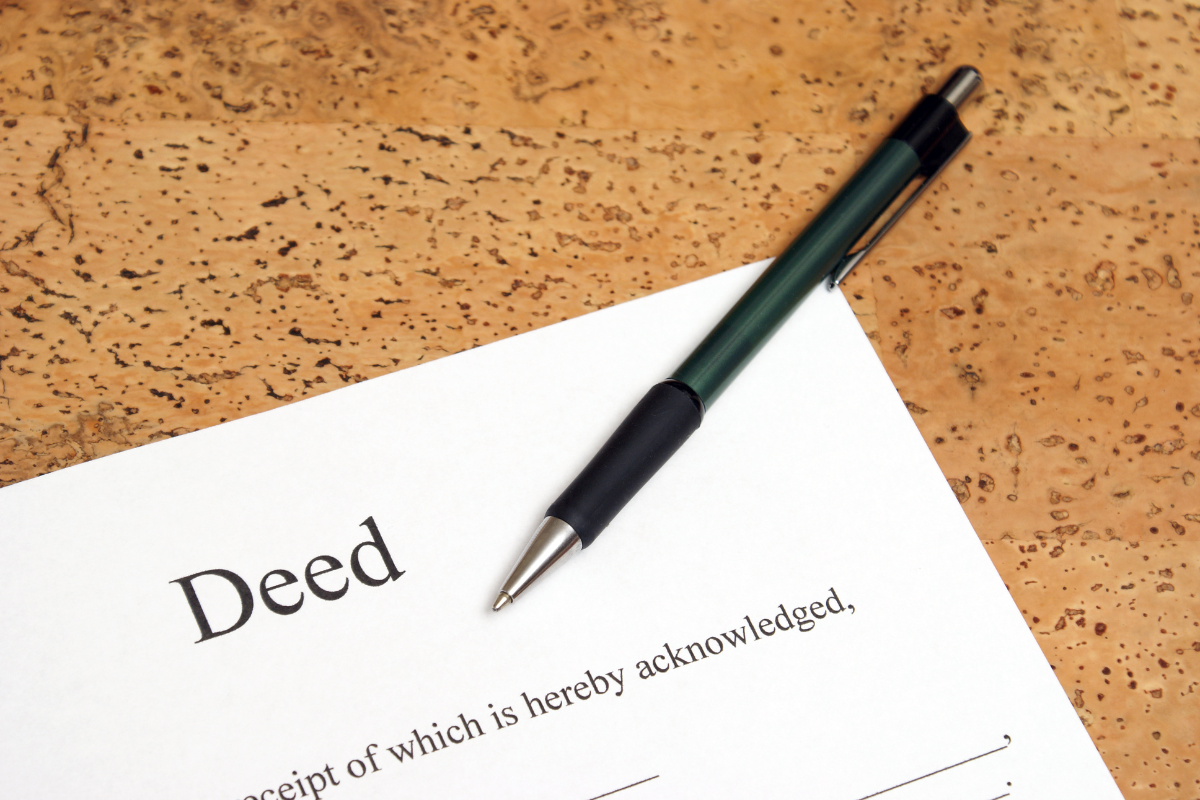Post Disclaimer: This blog reflects the author's personal experience with end-of-life matters and is provided in good faith for informational purposes only. While we aim to provide clear guidance on hard-to-find topics, this content is not legal advice and your use is at your own risk. Estate planning and end-of-life laws vary by location, so please consult your state's laws and seek guidance from a licensed attorney for your specific situation. We make no warranty about the accuracy or completeness of this information, which does not replace professional legal counsel. For more information, please see our full disclaimer.
For those who have recently lost a loved one, handling their estate and property matters can feel overwhelming during an already difficult time.
If you're responsible for managing these affairs, you may be concerned about complex legal processes, mounting costs, and time-consuming paperwork – all while grieving your loss.
Understanding how property transfers work after someone passes away is crucial for both those managing estates now and those planning ahead.
A transfer on death deed offers a particularly valuable solution, allowing property to pass directly to chosen beneficiaries without the lengthy probate process.
This article will guide you through the essentials of transfer on death deeds, explaining how they work, their benefits, and the steps involved in creating or executing one.
We'll cover common challenges you might face, important legal considerations, and practical tips for navigating property transfers during this sensitive time.

Understanding Transfer on Death Deeds: The Basics
A transfer on death (TOD) deed allows property owners to designate beneficiaries who will automatically inherit their property upon death.
This legal instrument functions similarly to a beneficiary designation on a life insurance policy or retirement account.
Just as you might designate someone to receive your retirement funds by simply naming them on a form, a TOD deed enables you to transfer real estate through a similar straightforward process.
To better understand this concept, imagine preparing a special package that will only be delivered after a specific event occurs.
The TOD deed works in much the same way – you prepare the documentation now, but the actual transfer doesn't take place until after your passing.
This timing aspect makes TOD deeds particularly valuable in estate planning.
Legal Definition and Purpose
From a legal perspective, a transfer on death deed creates a non-probate transfer of real property that takes effect only upon the death of the property owner.
The key distinction here is that unlike a traditional deed, which transfers property immediately, a TOD deed has no effect until the owner's death.
This means the property owner maintains complete control over their property during their lifetime, including the right to sell it, mortgage it, or even revoke the TOD deed entirely.
The purpose of this legal instrument is twofold: first, to provide property owners with flexibility in estate planning, and second, to offer a simplified method of transferring property that avoids the time and expense of probate proceedings.
This combination of flexibility and efficiency makes TOD deeds an increasingly popular choice in estate planning.
Eligible Properties for Transfer
When considering a TOD deed, it's important to understand which types of property qualify for this transfer method.
Generally speaking, TOD deeds can be used for:
Real estate properties, including:
- Single-family homes
- Vacant land
- Commercial properties
- Multi-unit residential buildings
- Condominiums and cooperative apartments
- Agricultural land
However, certain types of property ownership may affect eligibility.
For instance, properties held in joint tenancy or as community property might have specific requirements or limitations regarding TOD deeds.
It's crucial to understand your property's current ownership structure before proceeding with a TOD deed.

The Significant Benefits of Transfer on Death Deeds
Understanding the advantages of TOD deeds helps explain their growing popularity in estate planning.
Let's explore these benefits in detail.
Probate Avoidance and Cost Savings
Perhaps the most compelling advantage of a TOD deed is the ability to avoid probate.
Probate, the court-supervised process of distributing a deceased person's assets, can be both time-consuming and expensive.
Consider these typical probate-related expenses:
- Court filing fees
- Attorney fees (often a percentage of the estate's value)
- Personal representative fees
- Publication costs for legal notices
- Professional appraisal fees
By using a TOD deed, your beneficiaries can avoid these costs entirely, as the property transfers automatically upon death.
This direct transfer can save thousands of dollars in probate-related expenses and significantly reduce the time required to transfer property ownership.
Flexibility and Control During Lifetime
Unlike other methods of transferring property, such as adding someone to a deed or creating a life estate, a TOD deed preserves the owner's complete control over the property during their lifetime.
This means you can:
- Sell the property
- Refinance or mortgage the property
- Modify property tax exemptions
- Change beneficiaries
- Revoke the TOD deed entirely
This flexibility proves invaluable when circumstances change, as they often do over time.
You maintain the freedom to adapt your estate planning decisions without the complications that might arise from other property transfer methods.

Creating and Executing a Transfer on Death Deed
The process of creating a TOD deed requires attention to detail and adherence to state-specific requirements.
While the basic steps remain consistent across jurisdictions, the exact requirements may vary.
Essential Documentation Requirements
To create a valid TOD deed, you'll need to prepare specific documentation that includes:
- The current property owner's legal name and address
- A complete legal description of the property
- The intended beneficiary's legal name and address
- Clear language indicating the transfer occurs upon death
- Any specific conditions or contingencies for the transfer
The document must also comply with state laws regarding deed formatting, including margin requirements, font size, and other technical specifications.
While templates are available, ensuring compliance with local requirements is crucial for the deed's validity.
Understanding Capacity and Consent
When executing a TOD deed, the property owner must have the legal capacity to make such decisions.
This means they must:
- Understand the nature and effect of the document
- Act of their own free will
- Be able to identify their property and beneficiaries
- Comprehend the impact of their decision
This requirement helps protect vulnerable individuals from exploitation while ensuring the validity of the transfer.
Recording Requirements and Timeline
After executing the TOD deed, proper recording is essential for its effectiveness.
This typically involves:
- Having the document notarized
- Filing the deed with the county recorder's office
- Paying any required recording fees
- Maintaining copies of the recorded deed
The timeline for recording is important – while some states require recording within a specific period after execution, others simply require recording before the owner's death for the deed to be effective.

Navigating Common Challenges and Considerations
While TOD deeds offer many advantages, understanding potential challenges helps in making informed decisions about their use.
Multiple Beneficiaries and Contingency Planning
When naming multiple beneficiaries, consider:
- How the property will be divided
- What happens if a beneficiary predeceases the owner
- Whether beneficiaries must act unanimously in property decisions
- The potential for conflicts among beneficiaries
Clear documentation of these decisions helps prevent future disputes and ensures your wishes are carried out effectively.
Impact on Tax Planning and Public Benefits
TOD deeds can have various implications for:
- Capital gains tax basis
- Estate tax calculations
- Property tax assessments
- Medicaid eligibility and recovery
Understanding these implications helps in creating a comprehensive estate plan that considers both transfer efficiency and tax consequences.

FAQs: Transfer on Death Deeds
What happens if I have an existing mortgage when I create a Transfer on Death Deed?
A Transfer on Death deed transfers property subject to any existing mortgages or liens.
This means your beneficiaries will inherit both the property and the responsibility for any outstanding mortgage.
The mortgage company retains its rights to the property, and your beneficiaries will need to either continue making payments or refinance the loan.
It's important to note that most mortgage agreements include a "due on death" clause, which means the entire loan balance could become due when the property transfers.
However, federal law protects family members who inherit property and gives them special rights to assume the mortgage under its existing terms.
Can I use a Transfer on Death Deed if I own property with someone else as joint tenants?
The rules for using TOD deeds with jointly owned property depend on how you own it.
If you own property as joint tenants with rights of survivorship, your interest automatically passes to the surviving owner(s) regardless of any TOD deed.
You can only create a TOD deed for your share of property owned as tenants in common.
Some states allow joint owners to create a TOD deed together, specifying who receives the property after both owners have passed away.
This arrangement, sometimes called a "joint TOD deed," can be particularly useful for married couples who want to ensure their property passes to their children after both spouses are gone.
How does a Transfer on Death Deed affect property taxes and real estate assessments?
Creating a TOD deed has no immediate impact on property taxes or assessments since it doesn't transfer any current ownership rights.
However, when the property transfers after death, it may trigger a reassessment depending on state law.
Some states offer continued property tax benefits to family members who inherit through a TOD deed, particularly for senior citizen or disabled person exemptions.
Additionally, some jurisdictions have special provisions that prevent property tax increases when property transfers to close family members, whether through a TOD deed or other means.
The specific rules vary significantly by location, so it's important to understand your local tax implications.
What happens if my beneficiary has creditors or files for bankruptcy?
One advantage of TOD deeds is that they protect the property from your beneficiary's creditors during your lifetime.
Since beneficiaries have no current rights to the property, their creditors cannot place liens against it or force its sale to satisfy debts.
However, once the property transfers after death, it becomes subject to the beneficiary's creditors like any other asset they own.
If your beneficiary is in bankruptcy when they inherit, the property may become part of their bankruptcy estate.
For this reason, some people choose to transfer property to a trust instead of using a TOD deed when they have concerns about beneficiaries' creditors.
Can I create a Transfer on Death Deed that only becomes effective if my primary beneficiary predeceases me?
Yes, TOD deeds can include contingent beneficiaries who inherit only if the primary beneficiary dies before you.
You can create various contingency arrangements, such as naming alternate beneficiaries or specifying how the property should be distributed if multiple beneficiaries predecease you.
Some states even allow for more complex arrangements, like creating a TOD deed that only takes effect if your spouse doesn't survive you by a certain number of days.
The key is to clearly specify these contingencies in the deed itself.
Without clear alternate provisions, if your named beneficiary dies before you and you haven't updated the deed, the property may end up going through probate despite your efforts to avoid it.
What is the difference between a Transfer on Death deed and a Lady Bird deed?
A Transfer on Death (TOD) deed and a Lady Bird deed are both estate planning tools that allow property to transfer outside of probate, but they differ significantly in their structure and the rights they confer during the owner's lifetime.
A TOD deed functions like a beneficiary designation on a bank account, allowing the property to pass directly to named beneficiaries upon death while giving the owner complete control during their lifetime, including the right to sell or mortgage the property and change beneficiaries at any time.
In contrast, a Lady Bird deed (also called an enhanced life estate deed) creates an immediate future interest for the beneficiaries while still allowing the owner to retain full control during their lifetime.
This includes the right to sell or mortgage without beneficiary consent, but it offers additional Medicaid planning advantages since the transfer is considered complete when the deed is created rather than at death.
This potentially helps protect the property from Medicaid estate recovery while still allowing the owner to qualify for benefits after the five-year lookback period has passed.

Wrap-up: Making an Informed Decision
Transfer on death deeds represent a valuable tool in estate planning, offering a balance of control, flexibility, and efficiency in property transfer.
While they may not suit every situation, understanding their features and benefits helps in making informed decisions about their use in your estate plan.
Consider consulting with legal professionals familiar with your state's laws to ensure a TOD deed aligns with your overall estate planning goals.
Their expertise can help navigate specific requirements and potential complications while ensuring your wishes for property transfer are effectively implemented.
Remember that estate planning is not a one-time event but a process that may need adjustment as circumstances change.
Regular review of your TOD deed arrangements, along with other estate planning documents, helps ensure they continue to serve your intended purpose and protect your loved ones' interests.
Check out the Up & Doing glossary page for an alphabetical listing of key terms related to estate administration, funeral planning, and other end-of-life topics.




